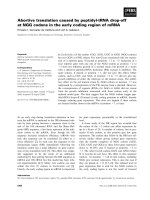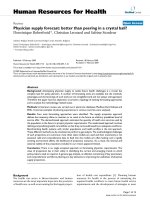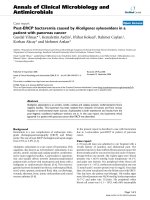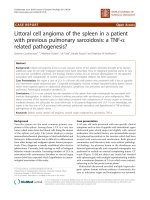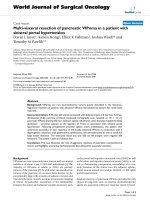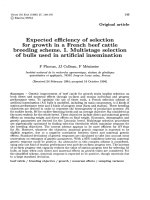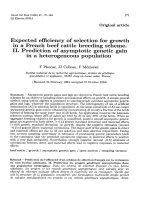Báo cáo sinh học: "Post-ERCP bacteremia caused by Alcaligenes xylosoxidans in a patient with pancreas cancer" pps
Bạn đang xem bản rút gọn của tài liệu. Xem và tải ngay bản đầy đủ của tài liệu tại đây (206.48 KB, 3 trang )
BioMed Central
Page 1 of 3
(page number not for citation purposes)
Annals of Clinical Microbiology and
Antimicrobials
Open Access
Case report
Post-ERCP bacteremia caused by Alcaligenes xylosoxidans in a
patient with pancreas cancer
Gurdal Yilmaz*
1
, Kemalettin Aydin
1
, Iftihar Koksal
1
, Rahmet Caylan
1
,
Korhan Akcay
1
and Mehmet Arslan
2
Address:
1
Department of Infectious Diseases and Clinical Microbiology, Karadeniz Technical University School of Medicine, Trabzon, Turkey and
2
Department of Gastroenterology, Karadeniz Technical University School of Medicine, Trabzon, Turkey
Email: Gurdal Yilmaz* - ; Kemalettin Aydin - ; Iftihar Koksal - ;
Rahmet Caylan - ; Korhan Akcay - ; Mehmet Arslan -
* Corresponding author
Abstract
Alcaligenes xylosoxidans is an aerobic, motile, oxidase and catalase positive, nonfermentative Gram
negative bacillus. This bacterium has been isolated from intestine of humans and from various
hospital or environmental water sources. A.xylosoxidans is both waterborne and results from the
poor-hygienic conditions healthcare workers are in. In this case report, the bacteremia which
appeared in a patient with pancreas cancer after ERCP was described.
Background
Bacteremia is a rare complication of endoscopic retro-
grade cholangiopancreatography (ERCP) and biliary
stents. The rate of post-ERCP cholangitis and sepsis ranges
from 0.5% to 3.0% [1,2].
Alcaligenes xylosoxidans is a rare cause of bacteremia. This
organism, also known as Achromobacter xylosoxidans, is an
aerobic, motile, oxidase and catalase positive, nonfermen-
tative Gram negative bacillus. A.xylosoxidans is opportun-
istic and usually affects severely immunocompromised
patients such as those with neutropenia and those with a
malignant or cardiovascular disease [3,4]. This microor-
ganism has been isolated from blood, cerebrospinal fluid,
stool, urine, sputum, peritoneal fluid, skin, ear discharge,
wounds, abscesses, bone, joints, endocardium and central
venous catheters [3-8].
In the present report is described a case with bacteremia
due to A.xylosoxidans post-ERCP in patient of pancreas
cancer.
Case report
A 70-year-old man was admitted to our hospital with a
10-day history of jaundice and abdominal pain. The
patient is known to have suffered from pancreas cancer for
three months and he was received second cycle of chemo-
therapy before one month. His vitality signs were: blood
pressure was 110/70 mmHg, body temperature 36.3°C
and pulse rate 68/min. His peripheral white blood cell
count was 6.4 × 10
9
/L, erythrocyte sedimentation rate was
72 mm/h and C-reactive protein was 4.6 mg/dL. Four days
later, the stent was placed into the biliary tract with ERCP.
One day later, the patient was lethargic. His vitality signs
were: blood pressure was 90/50 mmHg, body temperature
39.7°C and pulse rate 112/min. His peripheral white
blood cell count was 14.1 × 10
9
/L with 86% neutrophils
Published: 01 September 2006
Annals of Clinical Microbiology and Antimicrobials 2006, 5:19 doi:10.1186/1476-0711-5-
19
Received: 29 May 2006
Accepted: 01 September 2006
This article is available from: />© 2006 Yilmaz et al; licensee BioMed Central Ltd.
This is an Open Access article distributed under the terms of the Creative Commons Attribution License ( />),
which permits unrestricted use, distribution, and reproduction in any medium, provided the original work is properly cited.
Annals of Clinical Microbiology and Antimicrobials 2006, 5:19 />Page 2 of 3
(page number not for citation purposes)
and 8% lymphocytes. His erythrocyte sedimentation rate
was 80 mm/h and C-reactive protein was 11.2 mg/dL.
Blood and urine specimens were taken for microbiology-
cal analysis. We started to administer empirical treatment
with ceftriaxone (1000 mg per 12 h; IV) to the patient. In
blood culture (Bactec 9240; Becton Dickinson, Sparks,
Md.), Gram negative bacillus was found to have repro-
duced. This microorganism identified with the help of
Phoenix system (Becton Dickinson, Sparks, Md.) and bio-
chemical tests. It was called as A.xylosoxidans. A.xylosoxi-
dans was distinguished from other Alcaligenes species by
acidification of oxidative-fermentative (OF) glucose and
xylose. Key characteristics of A.xylosoxidans are shown in
Table 1.
The urine culture was sterile. Three days later, the initial
treatment was modified to ciprofloxacine (200 mg per 12
h; IV) according to antimicrobial susceptibility test. In-
vitro susceptibility data are shown in Table 2. This isolate
is an ESBL producer. Five days later, the clinical condition
of the patient improved. He was discharged in a good clin-
ical condition after 15 days.
Discussion
Obstruction of the bile duct by stones or tumor can facil-
itate bacterial colonization; subsequent instrumentation
has resulted in bacteremia rates mean 18.0%. [9,10]. The
highest bacteremia rates are seen in therapeutic ERCP. In
purely diagnostic ERCP, the bacteremic rate is lower at 8%
[10,11]. The microorganism most responsible for post-
ERCP bacteremia is Escherichia coli [9]. A.xylosoxidans is a
rare but important cause of bacteremia in immunocom-
promised patients. The gastrointestinal tract has been sug-
gested as a source for A.xylosoxidans bacteremia in patients
with cancer [12]. Our case report is the first one associated
with A.xylosoxidans that causes post-ERCP bacteremia.
A.xylosoxidans has been isolated from intestine of humans
and from various hospital or environmental water sources
[13]. The natural sources of A.xylosoxidans infections are
well water, tap water, swimming pools, and moist soil
[14,15]. A.xylosoxidans causing nosocomial infections is
waterborne (disinfectant solutions, intravenous fluids,
dialysis solutions) and results from the fact that health-
care workers do not use gloves [13,15,16]. In our case,
peripheral factors wereanalysed as a source of infection
but any environmental contamination couldn't be indi-
cated. Thatthe patient had symptoms of infection one day
after ERCP made us think that the infection was from the
intestines.
A.xylosoxidans is a weakly virulent microorganism. In gen-
eral, there is an underlying dissease in patients. A.xylosoxi-
dans have been reported in patients with cancer,
neutropenia, bone marrow or liver transplant, renal fail-
ure, cystic fibrosis, HIV infection, IgM deficiency,
neonates [4-6,15,17].
This report showed that A.xylosoxidans was sensitive to cef-
operazone/sulbactam, ciprofloxacin, imipenem, pipera-
cillin/tazobactam and trimethoprim/sulfametoxazole
and resistant to the third generation cephalosporins with
the exception of the cefoperazone/sulbactam, amikacin
and tobramycin. In previous studies, it was reported that
A.xylosoxidans was resistant to most of the antimicrobial
agents [15,17,18].
In summary, the post-ERCP bacteremia caused by A.xylos-
oxidans was presented in a 70-year-old man with pancreas
cancer. The case report may help to redefine the role of
A.xylosoxidans in post ERCP infections. The association of
A.xylosoxidans with bacteremia further extends the clinical
spectrum of this rare pathogen. This unusual case high-
lights that an effective antimicrobial therapy based on an
immediate microbiologycal analysis may be life-saving in
patients presenting a severe complication of ERCP.
Table 1: Key characteristics of A.xylosoxidans
Tests Results
Oxidase +
Catalase +
OF xylose Acid reaction
OF glucose Acid reaction
Arginine -
Citrate +
Ketoglutaric acid +
Gamma glutamil +
NO
3
to NO
2
+
Acetamide +
Lysine -
Mannitol -
Urease -
Motility +
Table 2: In-vitro susceptibility profile of A.xylosoxidans
Antimicrobial agent Susceptibility
Amikacin Resistant
Cefoperazone/sulbactam Sensitive
Cefotaxime Resistant
Ceftazidime Resistant
Ceftriaxone Resistant
Ciprofloxacin Sensitive
Imipenem Sensitive
Piperacillin/tazobactam Sensitive
Tobramycin Resistant
Trimethoprim/sulfametoxazole Sensitive
Publish with BioMed Central and every
scientist can read your work free of charge
"BioMed Central will be the most significant development for
disseminating the results of biomedical research in our lifetime."
Sir Paul Nurse, Cancer Research UK
Your research papers will be:
available free of charge to the entire biomedical community
peer reviewed and published immediately upon acceptance
cited in PubMed and archived on PubMed Central
yours — you keep the copyright
Submit your manuscript here:
/>BioMedcentral
Annals of Clinical Microbiology and Antimicrobials 2006, 5:19 />Page 3 of 3
(page number not for citation purposes)
References
1. Loperfido S, Angelini G, Benedetti G, Chilovi F, Costan F, De Berar-
dinis F, De Bernardin M, Ederle A, Fina P, Fratton A: Major early
complications from diagnostic and therapeutic ERCP: a pro-
spective multicenter study. Gastrointest Endosc 1998, 48:1-10.
2. Masci E, Toti G, Mariani A, Curioni S, Lomazzi A, Dinelli M, Minoli G,
Crosta C, Comin U, Fertitta A, Prada A, Passoni GR, Testoni PA:
Complications of diagnostic and therapeutic ERCP: a pro-
spective multicenter study. Am J Gastroenterol 2001, 96:417-423.
3. Duggan JM, Goldstein SJ, Chenoweth CE, Kauffman CA, Bradley SF:
Achromobacter xylosoxidans bacteremia: report of four
cases and review of the literature. Clin Infect Dis 1996,
23:569-576.
4. Aisenberg G, Rolston KV, Safdar A: Bacteremia caused by Achro-
mobacter and Alcaligenes species in 46 patients with cancer
(1989–2003). Cancer 2004, 101:2134-2140.
5. Gradon JD, Mayrer AR, Hayes J: Pulmonary abscess associated
with Alcaligenes xylosoxidans in a patient with AIDS. Clin
Infect Dis 1993, 17:1071-1072.
6. Ahn Y, Kim NH, Shin DH, Park OY, Kim W, Jeong MH, Cho JG, Park
JC, Kang JC: Pacemaker lead endocarditis caused by Achro-
mobacter xylosoxidans. J Korean Med Sci 2004, 19:291-293.
7. Weissgold DJ, Kirkpatrick B, Iverson M: Acute postoperative
Alcaligenes xylosoxidans endophthalmitis. Retina 2003,
23:578-580.
8. Ramos JM, Domine M, Ponte MC, Soriano F: Bacteremia caused
by Alcaligenes (Achromobacter) xylosoxidans. Description
of 3 cases and review of the literature. Enferm InfeccMicrobiol
Clin 1996, 14:436-440.
9. Leung JW, Ling TK, Chan RC, Cheung SW, Lai CW, Sung JJ, Chung
SC, Cheng AF: Antibiotics, biliary sepsis, and bile duct stones.
Gastrointest Endosc 1994, 40:716-721.
10. Kullman E, Borch K, Lindstrom E, Ansehn S, Ihse I, Anderberg B: Bac-
teremia following diagnostic and therapeutic ERCP. Gastroin-
test Endosc 1992, 38:444-449.
11. Mollison LC, Desmond PV, Stockman KA, Andrew JH, Watson K,
Shaw G, Breen K: A prospective study of septic complications
of endoscopic retrograde cholangiopancreatography.
J Gas-
troenterol Hepatol 1994, 9:55-59.
12. Legrand C, Anaissie E: Bacteremia due to Achromobacter
xylosoxidans in patients with cancer. Clin Infect Dis 1992,
14:479-484.
13. Vu-Thien H, Darbord JC, Moissenet D, Dulot C, Dufourcq JB, Marsol
P, Garbarg-Chenon A: Investigation of an outbreak of wound
infections due to Alcaligenes xylosoxidans transmitted by
chlorhexidine in a burns unit. Eur J Clin Microbiol Infect Dis 1998,
17:724-726.
14. Spear JB, Fuhrer J, Kirby BD: Achromobacter xylosoxidans
(Alcaligenes xylosoxidans subsp. xylosoxidans) bacteremia
associated with a well-water source: case report and review
of the literature. J Clin Microbiol 1988, 26:598-599.
15. Reverdy ME, Freney J, Fleurette J, Coulet M, Surgot M, Marmet D,
Ploton C: Nosocomial colonization and infection by Achro-
mobacter xylosoxidans. J Clin Microbiol 1984, 19:140-143.
16. Gomez-Cerezo J, Suarez I, Rios JJ, Pena P, Garcia de Miguel MJ, de
Jose M, Monteagudo O, Linares P, Barbado-Cano A, Vazquez JJ:
Achromobacter xylosoxidans bacteremia: a 10-year analysis
of 54 cases. Eur J Clin Microbiol Infect Dis 2003, 22:360-363.
17. Weitkamp JH, Tang YW, Haas DW, Midha NK, Crowe JE Jr: Recur-
rent Achromobacter xylosoxidans bacteremia associated
with persistent lymph node infection in a patient with hyper-
immunoglobulin M syndrome. Clin Infect Dis 2000,
31:1183-1187.
18. Mandell WF, Garvey GJ, Neu HC: Achromobacter xylosoxidans
bacteremia. Rev Infect Dis 1987, 9:1001-1005.

